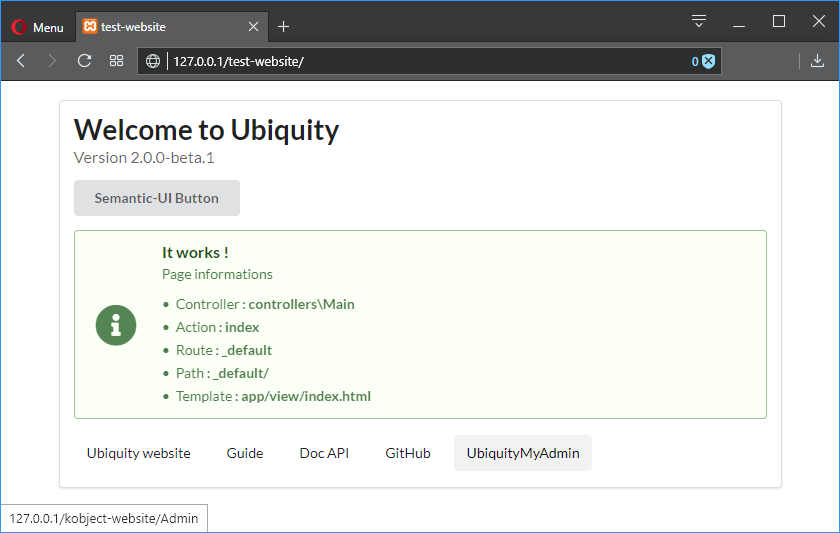Project configuration¶
Normally, the installer limits the modifications to be performed in the configuration files and your application is operational after installation

Main configuration¶
The main configuration of a project is localised in the app/conf/config.php file.
app/conf/config.php¶
1 2 3 4 5 6 7 8 9 10 11 12 13 14 15 16 17 18 | return array(
"siteUrl"=>"%siteUrl%",
"database"=>[
"dbName"=>"%dbName%",
"serverName"=>"%serverName%",
"port"=>"%port%",
"user"=>"%user%",
"password"=>"%password%"
],
"namespaces"=>[],
"templateEngine"=>'Ubiquity\views\engine\Twig',
"templateEngineOptions"=>array("cache"=>false),
"test"=>false,
"debug"=>false,
"di"=>[%injections%],
"cacheDirectory"=>"cache/",
"mvcNS"=>["models"=>"models","controllers"=>"controllers"]
);
|
Services configuration¶
Services loaded on startup are configured in the app/conf/services.php file.
app/conf/services.php¶
1 2 3 4 5 6 7 8 9 10 | use Ubiquity\controllers\Router;
try{
\Ubiquity\cache\CacheManager::startProd($config);
}catch(Exception $e){
//Do something
}
\Ubiquity\orm\DAO::startDatabase($config);
Router::start();
Router::addRoute("_default", "controllers\\IndexController");
|
Pretty URLs¶
Apache¶
The framework ships with an .htaccess file that is used to allow URLs without index.php. If you use Apache to serve your Ubiquity application, be sure to enable the mod_rewrite module.
.htaccess¶
AddDefaultCharset UTF-8
<IfModule mod_rewrite.c>
RewriteEngine On
RewriteBase /blog/
RewriteCond %{REQUEST_FILENAME} !-f
RewriteCond %{HTTP_ACCEPT} !(.*images.*)
RewriteRule ^(.*)$ index.php?c=$1 [L,QSA]
</IfModule>
Nginx¶
On Nginx, the following directive in your site configuration will allow “pretty” URLs:
location /{
rewrite ^/(.*)$ /index.php?c=$1 last;
}